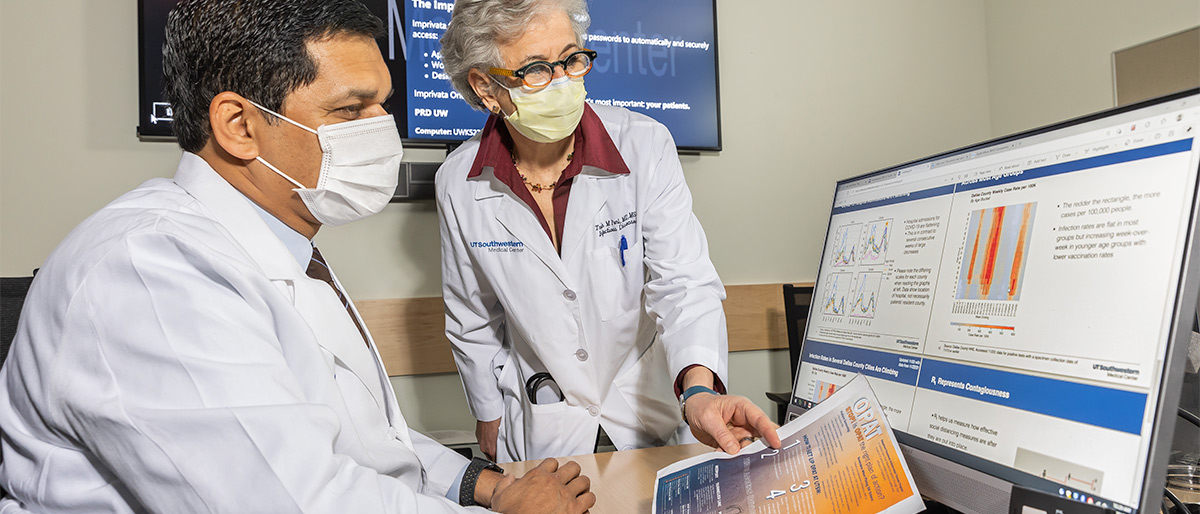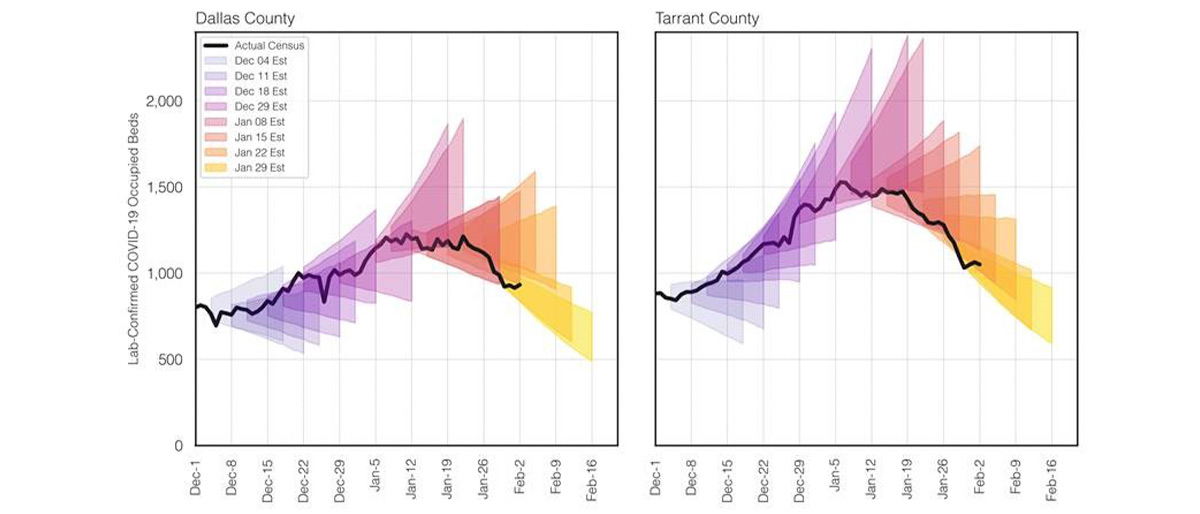COVID-19 forecasting team keeps region apprised of virus’s spread

Mujeeb Basit, M.D., Assistant Professor of Internal Medicine, wanted his team’s COVID-19 forecasting data to be helpful to North Texas citizens, government leaders, and school boards. Proof that the team reached the right audience came unexpectedly.
His wife was watching the Highland Park School Board meeting on her computer one day when suddenly she called out to him, “Oh, they’re looking at your graph!” He looked over and saw his team’s work on the screen as the school board discussed how to best protect students from the virus.
“It was so great to see real citizens using our data,” Dr. Basit said. “We worked very hard to provide data that is clear, accurate, and without bias so that it can be used by a broad population.”
This was the work of the data modeling team, a group of about 10 faculty and staff members who gathered in the onslaught of the COVID-19 crisis to help North Texas stay ahead of the pandemic. The team’s goal was to share accurate, relevant data to keep the spread of COVID-19 as low as possible, said Seth Toomay, M.D., Associate Vice President and Chief Medical Officer at UT Southwestern.

“There were patterns in the North Texas data that as physicians and scientists we were very concerned about. Positive tests lead to hospitalizations, hospitalizations to intubations, and intubations to deaths,” Dr. Toomay said. “We wanted to communicate these concerns to the whole community in a way that was easy to understand, and actionable in the same way that we would talk to our friends and neighbors about where the pandemic was heading.”
In the spring of 2020 during the initial onset of the pandemic in North Texas, the team’s assembly was hurried, but UT Southwestern had been building expertise for years. UTSW leaders in bioinformatics, data modeling, clinical informatics, geospatial mapping, public health, data analytics and interpretation, surveillance, and infectious diseases convened with a sense of urgency and a shared mission.
“We were initially charged with helping the institution to anticipate and plan for needed resources. We soon recognized that there was a void in available and integrated information in the North Texas region that could provide the public with a view of how the pandemic was affecting the area,” said Trish Perl, M.D.,M.Sc., Chief of the Division of Infectious Diseases and Geographic Medicine. “Overall, this effort has been so impactful in helping understand, manage, and set the expectations for COVID in the region.”
The team met at all hours – day and night if needed – initially utilizing data from Dallas and Tarrant counties, then from state and regional resources, national data from the Centers for Disease Control and Prevention and, most recently, North Texas data from UT Southwestern and Texas Health Resources. They harnessed UT Southwestern’s expertise to accurately synthesize this massive data trove to make predictions on spread of the virus.
“At UT Southwestern, we tend to be more collegial, I would say, and we work really well together to bring a project to fruition,” Dr. Basit said. “We check egos at the door of the meeting and make sure we are working toward a common goal.”
They turned out meaningful reports on COVID-19 that included percent positivity of those tested, the evolution of cases and hospitalizations, vaccination rates, and mask-wearing. Mobility reports included details down to retail shopping, grocery shopping, and people’s visits to the workplace and public parks. They also used this information to predict the trajectory of the pandemic – information that was used by many across the region.
Web traffic showed the data was heavily viewed by the media – and hindsight showed it was incredibly accurate.
“The predictions have performed well. Given data quality issues – especially retrospective changes to the data stream by state agencies – it is extremely hard to assess perfect accuracy, but the predictions have been within our error bars and extremely accurate in the near term,” Dr. Basit said. “We will continue forecasting of COVID-19 and new variants. We will also work to package data so that more people can use it within the bounds of the data use agreements. If we are able to get funding, we hope to create a permanent advanced data analytics and do more innovative and creative solutions with our data.”
Dr. Perl holds the H. Ben and Isabelle T. Decherd Chair in Internal Medicine in Honor of Henry M. Winans, Sr., M.D.

